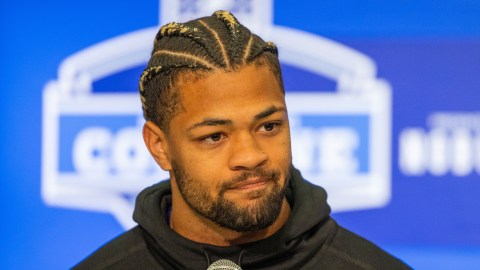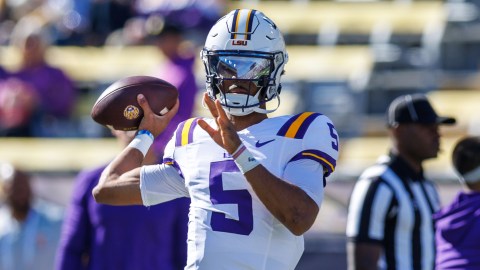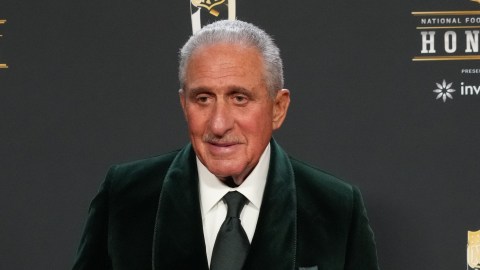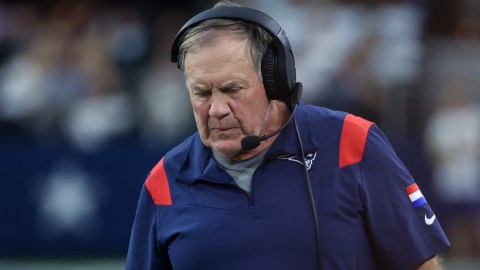 Sometimes, despite all the talent and previous production in the world, a change of scenery can be the worst thing for a veteran NFL player.
Sometimes, despite all the talent and previous production in the world, a change of scenery can be the worst thing for a veteran NFL player.
Just because a player appeared to be a future star with one team — and in one system — doesn’t mean he’ll be worth the enormous cost required to acquire him either through trade or free agency.
On Monday, we saw the Atlanta Falcons — amid an 8-1 record, and their best start in franchise history — release defensive end Ray Edwards. The sudden cut may not have come as much of a surprise if you looked at his recent playing time, but given his monster five-year, $27.5 million contract, the transaction turned some heads.
Edwards was a star in the making with the Minnesota Vikings, playing with a very talented defensive line, across from Jared Allen and next to Pat Williams and Kevin Williams. It’s no wonder that Edwards, the youngest of the four starters, went largely ignored by opposing blockers on his way to eight sacks in 2010 and 8 1/2 in 2009. Edwards was one of the best pass rushers in the league those two years. He ranked 11th, second and seventh in 2008, 2009 and 2010 respectively in total pressures among defensive ends. The fact that he played left defensive end — a position usually saved for better run defenders — made that even more impressive.
Edwards’ success did not carry on to Atlanta, however. He ranked 30th among defensive ends in pressures in 2011 and 61st before his release in 2012. He also saw himself stripped from his starting role in Week 8 to reality TV star Kroy Biermann. No offense to the Falcons’ starting defensive line, but it doesn’t stack up to the 2000’s Vikings. With more attention given to Edwards, the more his pass rushing productivity disappeared. According to Pro Football Focus, Edwards still rated highly as a run defender, but he simply wasn’t worth the high price tag.
Edwards isn’t an isolated case among high-priced acquisitions struggling in their new homes. Stanford Routt was recently waived after the Kansas City Chiefs gave him a three-year, $20 million contract this offseason. We’ve also seen Mario Williams struggle for the Buffalo Bills and Nnamdi Asomugha struggle in his transition from the Oakland Raiders to the Philadelphia Eagles.
Williams got the richest contract ever for a defensive player — $96 million over six years with $50 million guaranteed — while Asomugha was signed by the Eagles in 2011 to a five-year $60 million contract with $25 million guaranteed. In Williams’ case, injuries have been a major problem. In Asomugha’s case, the Eagles assumed that the star cornerback would be able to transition smoothly from a strictly press-man cornerback to more of a jack of all trades zone defender. Needless to say, the acquisition has not been worth the cost associated with it.
There have, of course, been positive veteran acquisitions over the last few years. Look no further than Peyton Manning in Denver, Brandon Marshall in Chicago or Cortland Finnegan in St. Louis. But for each one of those players, there’s also a Robert Meachem, BenJarvus Green-Ellis or Frostee Rucker that may have you scratching your head over why NFL decision makers thought those players were worth so much in the first place.
Even though NFL teams have numerous pro scouts set up to decide whether a certain player can transition from one scheme to another, sometimes it just doesn’t translate. Mark Anderson was a wonderful 2011 pickup for the Patriots, but even before getting injured, he wasn’t panning out in 2012 for the Bills.
Free agent acquisitions are much like draft picks. It’s essentially a 50-50 shot whether it will pan out or not. That’s even the case for dependable players like Green-Ellis, or truly elite players like Williams and Asomugha. NFL teams would be better suited to spend more on their own free agent players to keep them in town.
The Patriots made a big decision in acquiring Aqib Talib for a fourth-round pick at the trade deadline. Expectations are astronomical in New England, but if for one reason or another this deal doesn’t work out for New England, don’t be surprised.
The Patriots have another major decision in the offseason over whether to pay up for Wes Welker, or let him hit the market. If he doesn’t get re-signed by New England, an NFL team must decide if they’re getting a Vincent Jackson or Brandon Lloyd, or if they will be getting a Chad Johnson or Steve Breaston.
Welker looks great receiving throws from Tom Brady, but how will the 31-year-old look with a lesser quarterback in a new offense? That’s for NFL general managers to decide next year, but buyer beware.
Photo via Facebook/AtlantaFalcons




